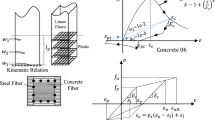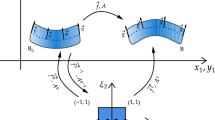Abstract
Over the past 2 decades, tight restriction has been imposed on strength criteria of concrete by the combination of plasticity and damage in one theory. The present study aims at constructing plastic/damage loading functions for elastoplastic damage models for concrete that can perform more satisfactorily in 3D stress states. Numerous strength criteria of concrete are reorganized according to their simplest representations as Cartesian, cylindrical, mixed cylindrical-Cartesian, and other forms, and the homogeneity of loading functions discussed. It is found that under certain supplementary conditions from physical meanings, an unambiguous definition of the cohesion in a strength criterion, which is demanded in an elastoplastic damage model, is usually available in an explicit or implicit form, and in each case the loading function is still homogeneous. To apply and validate the presented theory, we construct the respective homogeneous damage and plastic loading functions and implant them into some widely used elastoplastic damage models for concrete, and their performances in triaxial compression prove to have improved significantly.
Similar content being viewed by others

References
Faria R, Oliver J, Cervera M. A strain-based plastic viscous-damage model for massive concrete structures. Int J Solids Struct, 1998, 35: 1533–1558
Wu J Y, Li J, Faria R. An energy release rate-based plastic-damage model for concrete. Int J Solids Struct, 2006, 43: 583–612
Carol I, Rizzi E, Willam K. On the formulation of anisotropic elastic degradation. I. Theory based on a pseudo-logarithmic damage tensor rate. Int J Solids Struct, 2001, 38: 491–518
Carol I, Rizzi E, Willam K. On the formulation of anisotropic elastic degradation. II. Generalized pseudo-Rankine model for tensile damage. Int J Solids Struct, 2001, 38: 519–546
Hansen E, Willam K, Carol I. Two-surface anisotropic damage/ plasticity model for plain concrete. In: de Borst R, ed. Proceedings of Framcos-4 Conference. Rotterdam: Balkema, 2001. 549–556
Abu Al-Rub R K, Kim S M. Computational applications of a coupled plasticity-damage constitutive model for simulating plain concrete fracture. Eng Fract Mech, 2010, 77: 1577–1603
Voyiadjis G Z, Taqieddin Z N, Kattan P I. Anisotropic damage-plasticity model for concrete. Int J Plast, 2008, 24: 1946–1965
Cicekli U, Voyiadjis G Z, Abu Al-Rub R K. A plasticity and anisotropic damage model for plain concrete. Int J Plast, 2007, 23: 1874–1900
Shao C J, Li J Z, Wu Y H. Pseudo-potential of elastoplastic damage constitutive model and its application. Int J Solids Struct, 2009, 46: 3894–3901
Zhu Q Z, Shao J F, Kondo D. A micromechanics-based thermodynamic formulation of isotropic damage with unilateral and friction effects. Eur J Mech A-Solids, 2011, 30: 316–325
Kim S M, Abu Al-Rub R K. Meso-scale computational modeling of the plastic-damage response of cementitious composites. Cem Concr Res, 2011, 41: 339–358
Li J, Ren X D. Stochastic damage model for concrete based on energy equivalent strain. Int J Solids Struct, 2009, 46: 2407–2419
Li J, Ren X D. Homogenization-based multi-scale damage theory. Sci China-Phys Mech Astron, 2010, 53: 690–698
Li J, Ren X D. Multi-scale based stochastic damage evolution. Eng Fail Anal, 2011, 18: 726–734
Resende L. A damage mechanics constitutive theory for the inelastic behavior of concrete. Comput Meth Appl Mech Eng, 1987, 60: 57–93
Zheng F G, Wu Z R, Gu C S, et al. A plastic damage model for concrete structure cracks with two damage variables. Sci China-Technol Sci, 2012, 55: 2971–2980
Simo J C, Ju J W. Strain- and stress-based continuum damage models—I. Formulation. Int J Solids Struct, 1987, 23: 821–840
Hatzigeorgiou G D, Beskos D E, Theodorakopoulos D D, et al. A simple concrete damage model for dynamic FEM applications. Int J Comput Eng Sci, 2001, 2: 267–286
Valliappan S, Yazdchi M, Khalili N. Seismic analysis of arch dam-a continuum damage mechanics approach. Int J Numer Methods Eng, 1999, 45: 1695–1724
Lee J, Fenves G L. Plastic-damage model for cyclic loading of concrete structures. J Eng Mech-ASCE, 1998, 124: 892–900
Lubliner J, Oliver J, Oller S, et al. A plastic-damage model for concrete. Int J Solids Struct, 1989, 25: 299–326
Shahbeyk S, Hosseini M, Yaghoobi M. Mesoscale finite element prediction of concrete failure. Comput Mater Sci, 2011, 50: 1973–1990
Yu T, Teng J G, Wong Y L, et al. Finite element modeling of confined concrete—II: Plastic-damage model. Eng Struct, 2010, 32: 680–691
Simulia. Abaqus Theory Manual Version 6.12. Providence: Simulia, 2012
Chen W F. Constitutive Equations for Engineering Materials. 2nd ed. New York: Elsevier, 1994
Grassl P, Jirasek M. Damage-plastic model for concrete failure. Int J Solids Struct, 2006, 43: 7166–7196
Zhang J, Zhang Z X, Chen C Y. Yield criterion in plastic-damage models for concrete. Acta Mech Solid Sin, 2010, 23: 220–230
Zhang J, Li J. Investigation into Lubliner yield criterion of concrete for 3D simulation. Eng Struct, 2012, 44: 122–127
Yu M H. Concrete Strength Theory and Application (in Chinese). Beijing: Higher Education Press, 2002
Hoek E, Carranza-Torres C T, Corkum B. Hoek-Brown failure criterion—2002 edition. In: Proceedings of the 5th North American Rock Mechanics Symposium, vol. 1. Toronto: University of Toronto Press, 2002. 267–273
François M. A new yield criterion for the concrete materials. C R Méc, 2008, 336: 417–421
Christensen R M, Freeman D C, DeTeresa S J. Failure criteria for isotropic materials, applications to low-density types. Int J Solids Struct, 2002, 39: 973–982
Bigoni D, Piccolroaz A. Yield criteria for quasibrittle and frictional materials. Int J Solids Struct, 2004, 41: 2855–2878
Chorin A, Huehes T J R, McCracken M F, et al. Product formulas and numerical algorithms. Commun Pure Appl Math, 1978, 31: 205–256
Ju J W. On energy-based coupled elastoplastic damage theories: Constitutive modeling and computational aspects. Int J Solids Struct, 1989, 25: 803–833
Simo J C, Hughes T J R. Computational Inelasticity. New York: Springer-Verlag, 1998
Green S J, Swanson S R. Static Constitutive Relations for Concrete. AFWL-TR-72-244. US Air Force Weapons Laboratory, Kirtland Air Force Base, NM. 1973
Press W H, Flannery B P, Teukolsky S A, et al. Numerical Recipes in FORTRAN: The Art of Scientific Computing. 2nd ed. Cambridge: Cambridge University Press, 1992
Mander J B, Priestley M J N, Park R. Theoretical stress-strain model for confined concrete. J Struct Eng-ASCE, 1988, 114: 1804–1826
Zhang J, Ren X D, Li J. Combined positive-negative and hydrostatic-deviatoric splits of stress for construction of 3D damage models. In: Yang Y B, Leu L J, Chen C D, eds. Proceedings of the 3rd International Symposium on Computational Mechanics. Taipei: National Taiwan University Press, 2011. 426–427
Zhang J, Li J. Three-parameter damage model for quasi-brittle solids. In: Proceedings of the 8th European Solid Mechanics Conference. Graz: Euromech, 2012
Author information
Authors and Affiliations
Corresponding author
Rights and permissions
About this article
Cite this article
Zhang, J., Li, J. Construction of homogeneous loading functions for elastoplastic damage models for concrete. Sci. China Phys. Mech. Astron. 57, 490–500 (2014). https://doi.org/10.1007/s11433-013-5188-0
Received:
Accepted:
Published:
Issue Date:
DOI: https://doi.org/10.1007/s11433-013-5188-0



